
Publisher:
Bonnie King
CONTACT:
Newsroom@Salem-news.com
Advertising:
Adsales@Salem-news.com

~Truth~
~Justice~
~Peace~
TJP
Mar-20-2011 21:46


 TweetFollow @OregonNews
TweetFollow @OregonNews
Playing Politics at Gaza's Rafah Crossing
Richard Lightbown Special to Salem-News.comWho controls the Rafah Crossing between Egypt and the Gaza Strip?
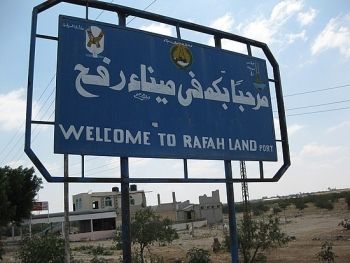 Rafah border crossing between Gaza and Egypt. Photo: travelpod.com |
(LONDON) - Hopes that the popular uprising in Egypt will lead to the permanent opening of the Rafah Crossing into the Gaza Strip suffered a setback on 13 March when an Anglo-French medical team of three surgeons was denied entry into the Strip by Egyptian officials.
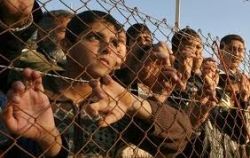 |
No reason was given for refusing a visit that had been arranged in conjunction with the French embassy two months previously. According to a report by Gisha, an Israeli organization that challenges restrictions on Palestinian movement, entitled “Rafah Crossing Who Holds the Keys?”
Israel, not the Egyptian government largely controls the Rafah Crossing. The other key players are the Hamas government, the Palestinian Authority (PA) in Ramallah, the European Union and the United States. It is no surprise then that the situation remains much as it did before the Egyptian revolt.
The 2005 agreement on movement and access
The operation of the Rafah Crossing is run according to the Agreement on Movement and Access (AMA) between the Palestinian Authority (PA) and Israel which was brokered by Condoleezza Rice in November 2005.
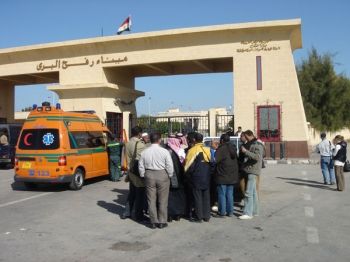 |
This was a comprehensive plan for the normalization of movement for people and goods within the Palestinian territories and across Palestinian borders. All crossings were to be open by the end of 2005 and were to operate continuously, while the refurbished crossing at Karni was intended to allow 400 trucks a day to pass between Israel and Gaza by the end of 2006. (In January and February this year, just before it was permanently closed, the crossing handled an average of 136 trucks per day, despite Israel’s well-publicized “easing” of the closure.)
Under the AMA the Rafah Crossing opened on 26 November 2005 for Palestinian identity card holders and other designated persons. It was also intended to cater for the export of goods, and for cars once sophisticated search equipment had been inaugurated. The EU had agreed to supply officials to ensure proper procedures were followed.
Cargo imports from Egypt were to enter Gaza through Kerem Shalom in the southwest corner of the Strip where they would be cleared by PA officials under Israeli supervision.
A further part of the agreement was that Israel would not close any of the crossings as the result of a security incident that was unconnected with the crossing itself.
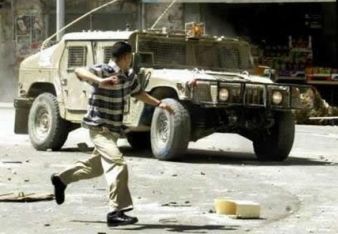 |
The Israeli military presence which had controlled the Gaza facilities at Rafah since January 2001 was withdrawn under the agreement, but Israel did not relinquish control. Despite claims to have lifted the occupation of Gaza, Israel still retains total control of the Palestinian population registry.
This determines who is officially resident and therefore eligible to use the crossing. (Palestinians who are designated non-resident must enter and leave Gaza by the Erez Crossing from Israel.) Israel also has the right to veto the use of the facility to foreigners, and it can close the crossing simply by ensuring that the conditions for its opening are not met.
The AMA requires that Israel supervises passengers from its control room at Kerem Shalom, while the EU observers who are billeted at Ashkelon need to enter Gaza through Kerem Shalom. Both conditions have been denied on the whim of Israeli authorities. (It is not clear why EU personnel are not accommodated in the Egyptian resort of Al-Arish, which is nearer to Rafah than Ashkelon and has a number of hotels including one five-star facility.)
Closures of the crossing
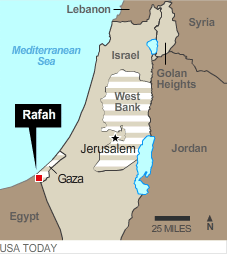
Following the signing of the Oslo accords in 1994 hundreds of trucks crossed through Rafah, but the crossing was closed (in breach of the agreement) for more than 70 per cent of the time during the year following the second intifada in 2000.
Traffic increased again during 2004 but imports through Rafah ceased under the Israeli disengagement plan in September 2005. The passage of exports was also denied, contrary to the AMA, However around 1,300 people passed each way during the nine-and-a-half hours the crossing was open each day.
The agreement was breached again when the crossing was closed following the capture of Gilad Shalit on 25 June 2006 and for the next year it remained closed for 86 per cent of the time.
The occasional openings were at random and at only two days’ notice, rendering forward travel plans impossible. It also left Gaza residents stranded in Egypt for days or sometimes weeks.
After Hamas took control of the Gaza Strip Israel implemented its policy of closure of the territory.
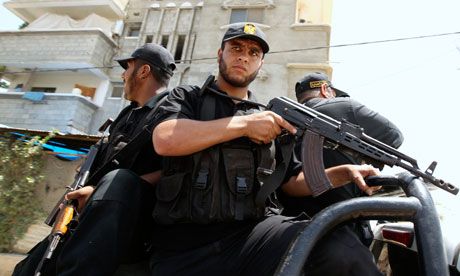 |
Rafah Crossing was closed to all traffic after 9 June 2007 when Hamas evicted the Presidential Guard and prevented the PA from fulfilling its designated duties.
Because of EU policy not to deal with Hamas the observer force was also suspended. (Apparently political principles override humanitarian considerations.) In consequence thousands were again stranded on the Egyptian side of the border, surviving in rented rooms and tent camps while descending into penury.
More than one thousand of them were patients returning after treatment in Egypt, 14 of whom died during July 2007. An Israeli proposal for them to return by Kerem Shalom was scuppered when Hamas shelled the crossing.
An arrangement was finally agreed between Egypt, Israel and the PA at the end of July 2007 whereby 6,374 people entered Israel by the Nitzana Crossing and were then bussed to the Erez Crossing to enter Gaza.
Egyptian unilateral Openings
In December 2007 Egypt allowed 2,200 pilgrims through the crossing to go to the Hajj in Mecca, without coordinating this with either the PA or Israel. (Israel had allowed a further 700 to pass through Erez in order to travel via Jordan.)
Upon their return Israel had requested that the pilgrims be allowed back through an Israeli-controlled crossing, which the Egyptian authorities originally agreed to. Fearing investigation and detention in Israel the pilgrims refused to comply and they were allowed to return via Rafah after violent protests. Israel protested that this contradicted agreements.
After a large section of the border wall was blown up by Hamas militants in January 2008 Egypt unilaterally allowed a small number of students to pass on to Cairo airport. While Gazans stormed the border to buy goods Israel and the US applied pressure on Egypt to “solve the problem”.
The border was again closed on 3 February by arrangement with Hamas. However the crossing was reopened early in March after the Ministry of Health in Gaza had declared a medical emergency following clashes between Gaza forces and the Israeli army.
One hundred and seven Palestinians had been killed and 250 injured. The crossing opened again between 31 December and 5 February 2009 in similar circumstances during Operation Cast Lead. After the war openings returned to an irregular format forcing students with overseas placements and patients requiring medical aid to cross the border through the tunnels.
Only state terrorism on the high seas against the Gaza flotilla finally shamed the Egyptian government to go it alone and open the crossing on a regular basis. Representatives from Physicians for Human Rights – Israel told the Turkel Commission in October that this had allowed supplies of medical equipment and medications that had not been available before the flotilla raid. (Turkel completely ignored this testimony when writing their report.)
Policy influences past and future
Pro-Israel lobbying of members of the US Congress resulted in a proposal in the House of Representatives to withhold 200 million dollars of Egypt’s 1.3 billion dollars military aid budget against certain requirements. This included stopping arms smuggling into Gaza (while inevitably restricting other traffic).
This was later substituted for an allocation of 23 million dollars from the budget to pay the cost of sending engineering teams to Rafah to detect tunnels. Egypt also increased its activities against the tunnels during the summer of 2008.
The official Egyptian position under President Hosni Mubarak was that the crossing remained shut because it was not possible to implement the AMA. Unofficially it was acknowledged that there were objections from the US, Israel and Europe, while Hamas affiliation with Mubarak’s political opponents, the Muslim Brotherhood, influenced the decision.
Israeli intentions to seal its borders with Gaza (while presumably maintaining its illegal naval blockade) have long been suspected and were voiced publicly by Foreign Minister Avigdor Lieberman in 2010. The previous Egyptian leadership was unwilling to have the political and economic responsibility of Gaza dumped upon it in this way.
Israel does not want an independent state in the Gaza Strip with free access to the Western and Arab worlds which could become the centre of the Palestinian struggle for liberation.
This might impinge on its policy of stealing portions of the West Bank.
Much could depend on how the popular revolt evolves in Egypt. Despite the initial empowerment of a population sympathetic to the plight of Gaza the end result is still uncertain and the cost to the economy has been extreme. (Income from tourism had exceeded 10 billion dollars in 2010. In February 2011 a Press TV film crew found a solitary Japanese tourist trying to blag her way into the pyramids.)
At the moment remnants of the old guard remain in positions of power where they will be susceptible to economic pressure from the US, aimed to a large extent at looking after Israel’s interests. From within these competing groupings the future operation of the Rafah Crossing will be decided in the short term.
In the medium term it remains to be seen how serious Mahmoud Abbas is in seeking a Palestinian reconciliation, which would allow for a normal resumption of the AMA. For the moment the status quo appears to prevail and Israel’s unremitting stranglehold on everyday life in Gaza remains largely intact.
This article was originally published by: Redress Information & Analysis
Articles for March 19, 2011 | Articles for March 20, 2011 | Articles for March 21, 2011



Quick Links
DINING
Willamette UniversityGoudy Commons Cafe
Dine on the Queen
Willamette Queen Sternwheeler
MUST SEE SALEM
Oregon Capitol ToursCapitol History Gateway
Willamette River Ride
Willamette Queen Sternwheeler
Historic Home Tours:
Deepwood Museum
The Bush House
Gaiety Hollow Garden
AUCTIONS - APPRAISALS
Auction Masters & AppraisalsCONSTRUCTION SERVICES
Roofing and ContractingSheridan, Ore.
ONLINE SHOPPING
Special Occasion DressesAdvertise with Salem-News
Contact:AdSales@Salem-News.com

Salem-News.com:
Terms of Service | Privacy Policy
All comments and messages are approved by people and self promotional links or unacceptable comments are denied.
[Return to Top]
©2025 Salem-News.com. All opinions expressed in this article are those of the author and do not necessarily reflect those of Salem-News.com.